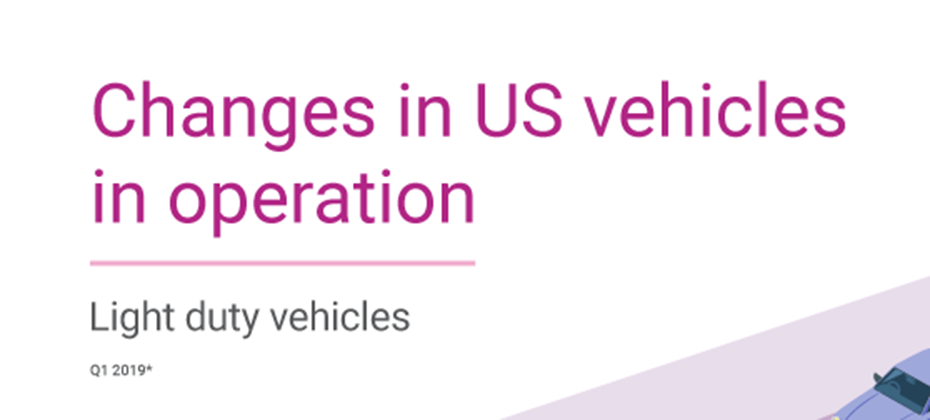Tag: Market Trends Report VIO

In the past 10 years, consumers begin purchasing convertibles as early as March.

Pickups are the most common vehicle in operation at 20% share today and hold 16.5% of new vehicle registrations in the market in Q1 2019.

There were 276 million vehicles on the road in Q1 2019.

Latest results from Experian's Market Trends report shows that 17.3 million new vehicles have been added to the U.S. Market of light-duty vehicles on the road.

Experian’s latest Market Trends and Loyalty report shows that for the first time in history, cars with four-cylinder engines have outpaced any other light-duty vehicle type on the road. That’s because the auto industry has been hard at work the past two decades improving both power and fuel efficiency of its engines. Auto manufacturers have been given aggressive fuel efficiency targets (54.5 mpg by 2025), but still need to meet consumer demand for performance. The net result is today’s average four-cylinder engine (188.1 hp) actually has more horsepower than the average V8 from 20 years ago (188 hp). It has helped four-cylinder engines become the most prominent engine type on the road, according to Experian Automotive Vehicles in Operation (VIO) database. Of the vehicles on the road, 37.7 percent are being powered by a four-cylinder engine, compared to 37.6 percent of six-cylinder engines. The top five vehicles at both the VIO and registration levels shows that all but one have four-cylinder engines. Top segments Total VIO Q3 vehicle registrations 1. Full-size pickup 1. Entry-level CUV 2. Standard midrange car 2. Full-size pickup 3. Small economy car 3. Small economy car 4. Lower midrange car 4. Standard midrange car 5. Entry-level CUV 5. Lower midrange car The four-cylinder VIO market share growth will continue in the future. In 2016, for example, four-cylinder engines accounted for 54.2 percent of all engines in new vehicles sold. It is the fifth consecutive year that four-cylinder engines had more than 50 percent market share. Market share for six-cylinder engines has dropped from 32.5 percent in 2012 to 29.7 percent in 2016, while eight-cylinder engines have dropped from 16.1 percent to 12.1 percent.

Environmentally friendly, lower fuel costs and tax incentives. These are all words that describe alternative-powered vehicles, and serve as reasons why many car shoppers flocked to their local dealerships over the past several years with the intent of “going green” with their next vehicle. However, that trend seems to be fading into the past. As gas prices continue to trend downward, we have seen more and more consumers steer away from hybrids. In fact, according to Experian’s recent Automotive Market Trends and Registrations analysis, when it came to fuel type, hybrids only made up 2.5 percent of the vehicles registered in the third quarter of 2015. This was a 19.2 percent drop from a year ago. Meanwhile, gas-powered vehicles dominated the market at nearly 94 percent. Furthermore, the analysis found that the hybrid car was the vehicle segment that suffered the second largest year-over-year decrease in registrations and its second consecutive quarterly decline, reducing by 19 percent. Conversely, the upper premium sports car (including vehicle models, such as the Porsche 911, Jaguar XJ and BMW 6-Series) saw the highest percentage increase, growing by 45 percent over the same time period. From an overall market perspective, the analysis found that through the third quarter of 2015, new vehicle registrations increased by 5.5 percent from the previous year – a clear sign that the market continues to trend in a positive direction. As previous Experian analyses have indicated, as long as consumers continue to stay on top of their monthly payments, the boom in new vehicle sales will be a positive sign for the industry. The analysis also examined the demographic characteristics of the new vehicle buyer, and found that nearly 50 percent of the new vehicle purchasing power in the U.S. falls to consumers between the ages of 40-69. What’s more, individuals with incomes from $50,000-$100,000 made up 35.5 percent of all new vehicle buyers. Like many things in life, the automotive market is ever changing. At one moment, a segment of vehicles could be selling like hot cakes, and the next moment suffer a steep decline in sales. Gaining insight into these types of trends enables manufacturers and retailers to better understand the fluctuations in the market, and more easily position their businesses for success. And the better positioned they are for success, the more “green” these companies will see.

Since Henry Ford invented the assembly line and mass automotive production began, the primary objective of all manufacturers and dealers has been to move new vehicle inventory off the lot year after year. But nowadays finding the right automotive customer can be a challenging task. Where do they live? How old are they? How much do they make? By leveraging data to answer these questions, manufacturers can market to the appropriate audience and manage inventory accordingly. In fact, a recent Experian analysis of the automotive market found that the top 10 states accounted for nearly 60 percent of all new vehicle registrations during the second quarter of 2015, led by California at 12.6 percent. The remainder of the top 10 included Texas (9.9 percent), Florida (7.9 percent), New York 5.7 percent), Pennsylvania (4.4 percent) Ohio (3.9 percent), Illinois (3.8 percent), Michigan (3.7 percent), New Jersey (3.5 percent) and Georgia (2.8 percent). Diving a bit deeper, the analysis also showed that through May 2015, nearly 50 percent of all new vehicle buyers fell within the 40-69 age range. Furthermore, 17.9 percent were between the ages of 50-59. The analysis also found that individuals with incomes from $50,000-$100,000 were the most active new car shoppers during the same time period, equating to nearly 36 percent of the market. Other findings include: Los Angeles and New York were the two DMAs with the highest market share for new vehicle registrations at 6.8 percent and 6.7 percent, respectively Toyota (13.5 percent), Ford (11.6 percent) and Chevrolet (10.8 percent) were the top 3 brands with highest new vehicle market share among retail buyers through Q2 2015 Entry-level CUVs accounted for the highest percentage of new vehicle registrations at 14.6 percent, followed by the small economy car (11.0 percent) and full-sized pickup trucks (10.7 percent) Leveraging data and analytics gives manufacturers and dealers a competitive advantage by enabling them to better understand the entire automotive market, specifically new vehicle trends. With these actionable insights, automotive companies will be positioned to make more confident inventory decisions and target specific consumers. And by better understanding whom they are targeting, manufacturers and dealers will be able to check their primary objective off the list.

Some of my fondest memories on road trips as a child were the games we were able to play. I’m sure many kids played “I Spy” and did “Sing-a-longs,” but my go-to game was “Slug Bug” (It’s a game where you get points for spotting a Volkswagen Beetle). While it’s been quite some time since I’ve played the game, I still find myself very aware of the different types of vehicles around me. As a matter of fact, if I were to play the game today, I’d probably rack up a number of points for the amount of cross-over utility vehicles (CUVs) I’ve seen on the road lately. There are quite a few. After reviewing Experian Automotive’s most recent Market Trends and Registration analysis, it all made sense. During the first quarter of 2015, the entry-level CUV was the top new registered vehicle segment, up 6.3 percent from a year ago. It also marked the fifth consecutive quarter that the entry-level CUV was the top-selling new vehicle segment. It was followed by the small economy car and a full-sized pickup truck. The analysis also found that it wasn’t just the CUV that saw an uptick in new registrations. In fact, seven of the top 10 new registered vehicle segments saw increases in sales from a year ago, and 16.6 million new vehicles overall found their way onto U.S. roads in the first quarter of 2015. The spike in new registrations combined with fewer vehicles going out of operation drove the number of vehicles on the road to nearly 253 million, its highest level since the second quarter of 2008. As CUVs continue to stand on top of the mountain of new vehicle sales, and small economy cars sprint pass the full-sized pickup truck, you might think similar patterns have emerged in the overall number of vehicles on the road. But it’s not necessarily the case. Despite falling to the third most purchased new vehicle segment, full-sized pickup trucks remain the most popular vehicle on the road, making up roughly 15 percent of the market. That said, entry-level CUVs have seen the most dramatic increase, rising 12.2 percent from a year ago. Trends in the automotive market can sometimes appear to be cyclical, which is why it’s important for the industry to pay close attention to the data sets available to them. By leveraging the data, dealers, retailers, and manufacturers can benefit from the insights to make better business decisions, whether it’s relocating inventory or adapting to consumer demand. Similarly, identifying what vehicles consumers are driving, can do more than help you win in “Slug Bug,” it can help you win in the market.